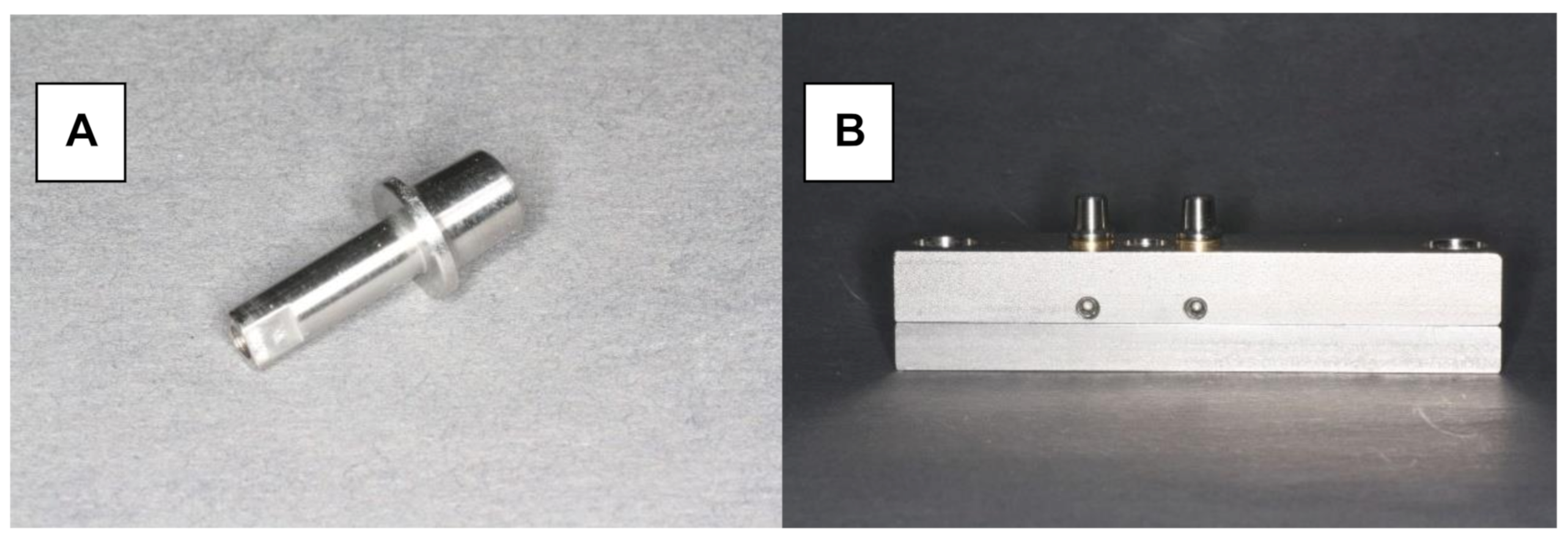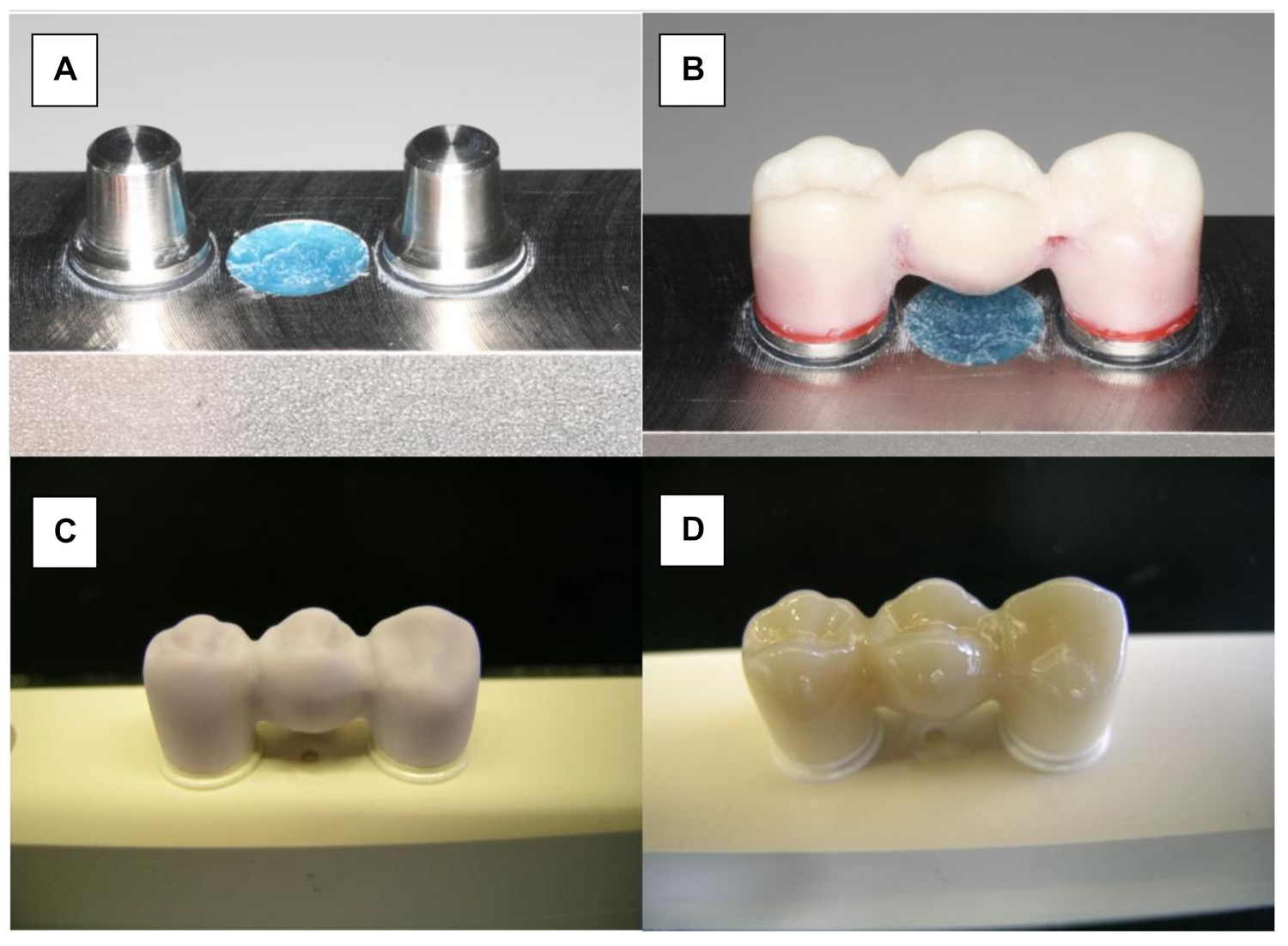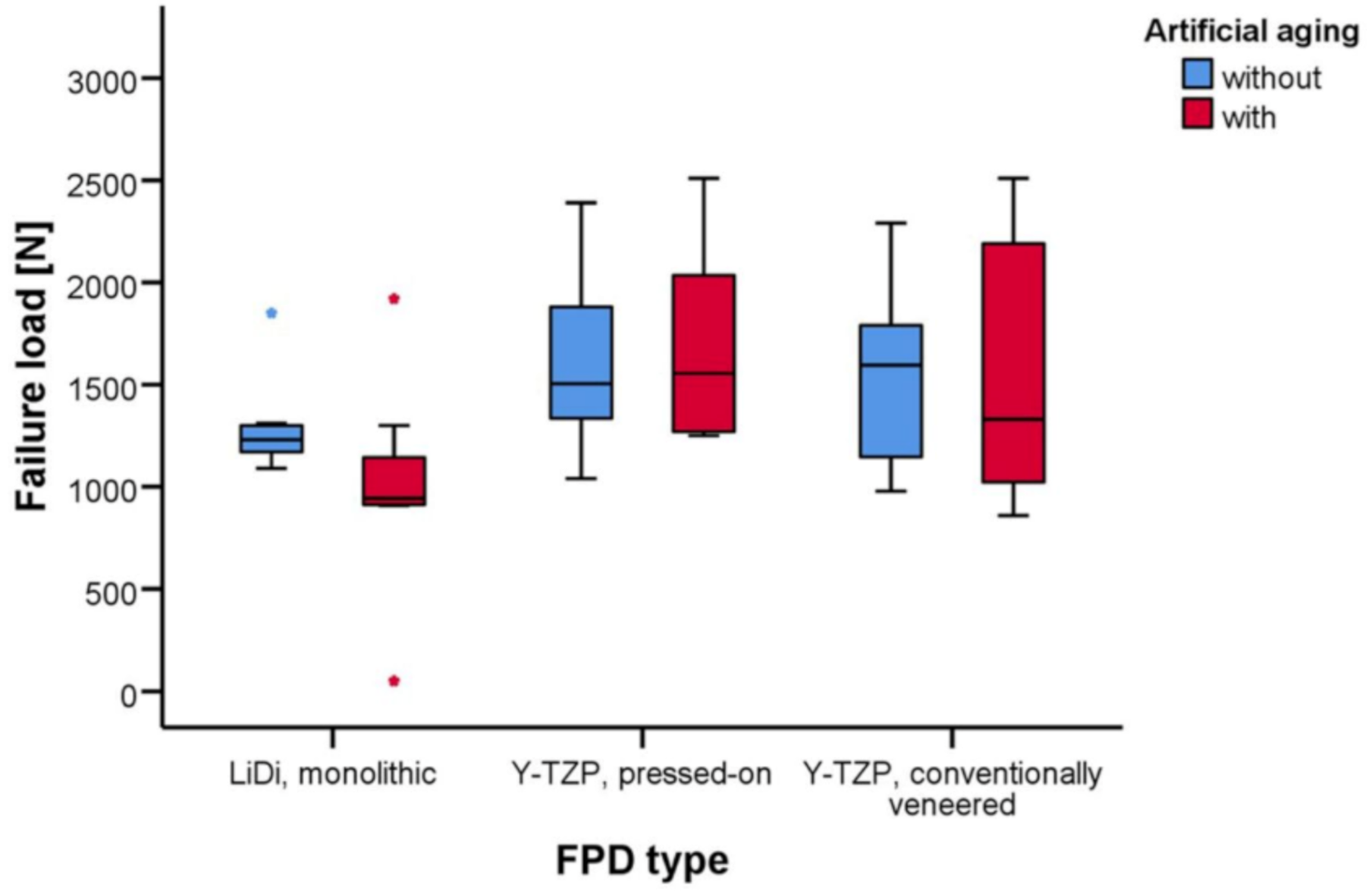Impact of the Veneering Technique and Framework Material on the Failure Loads of All-Ceramic Computer-Aided Design/Computer-Aided Manufacturing Fixed Partial Dentures
Abstract
:1. Introduction
2. Materials and Methods
- Ethics Statement:This article does not contain any studies with human participants or animals performed by any of the authors.
- Informed Consent:For this type of study, formal consent is not required. The authors have no conflict of interest and no funding to declare.
2.1. Fixed Dental Prostheses
2.2. Artificial Aging
2.3. Load-to-Failure
2.4. Statistics
3. Results
Load-to-Failure
4. Discussion
5. Conclusions
Author Contributions
Funding
Institutional Review Board Statement
Informed Consent Statement
Data Availability Statement
Acknowledgments
Conflicts of Interest
Disclosure Statement
References
- Denry, I.; Kelly, J. Emerging Ceramic-based Materials for Dentistry. J. Dent. Res. 2014, 93, 1235–1242. [Google Scholar] [CrossRef] [Green Version]
- Kern, M.; Sasse, M.; Wolfart, S. Ten-year outcome of three-unit fixed dental prostheses made from monolithic lithium disilicate ceramic. J. Am. Dent. Assoc. 2012, 143, 234–240. [Google Scholar] [CrossRef] [PubMed]
- Heintze, S.; Monreal, D.; Reinhardt, M.; Eser, A.; Peschke, A.; Reinshagen, J.; Rousson, V. Fatigue resistance of all-ceramic fixed partial dentures–Fatigue tests and finite element analysis. Dent. Mater. 2018, 34, 494–507. [Google Scholar] [CrossRef]
- Rekow, D.; Thompson, V.P. Engineering long term clinical success of advanced ceramic prostheses. J. Mater. Sci. Mater. Med. 2007, 18, 47–56. [Google Scholar] [CrossRef]
- Li, R.W.K.; Chow, T.W.; Matinlinna, J.P. Ceramic dental biomaterials and CAD/CAM technology: State of the art. J. Prosthodont. Res. 2014, 58, 208–216. [Google Scholar] [CrossRef] [PubMed] [Green Version]
- Solá-Ruiz, M.F.; Lagos-Flores, E.; Román-Rodriguez, J.L.; Highsmith, J.D.R.; Fons-Font, A.; Granell-Ruiz, M. Survival Rates of a Lithium Disilicate–Based Core Ceramic for Three-Unit Esthetic Fixed Partial Dentures: A 10-Year Prospective Study. Int. J. Prosthodont. 2013, 26, 175–180. [Google Scholar] [CrossRef] [PubMed] [Green Version]
- Rosentritt, M.; Krifka, S.; Strasser, T.; Preis, V. Fracture force of CAD/CAM resin composite crowns after in vitro aging. Clin. Oral Investig. 2020, 24, 2395–2401. [Google Scholar] [CrossRef] [PubMed]
- Lim, C.-H.; Jang, Y.-S.; Lee, M.-H.; Bae, T.-S. Evaluation of fracture strength for single crowns made of the different types of lithium disilicate glass–ceramics. Odontology 2020, 108, 231–239. [Google Scholar] [CrossRef] [PubMed]
- Marquardt, P.; Strub, J.R. Survival rates of IPS empress 2 all-ceramic crowns and fixed partial dentures: Results of a 5-year prospective clinical study. Quintessence Int. 2006, 37, 253–259. [Google Scholar] [PubMed]
- Sun, Q.; Chen, L.; Tian, L.; Xu, B. Single-Tooth Replacement in the Anterior Arch by Means of a Cantilevered IPS e.max Press Veneer-Retained Fixed Partial Denture: Case Series of 35 Patients. Int. J. Prosthodont. 2013, 26, 181–187. [Google Scholar] [CrossRef] [PubMed] [Green Version]
- Teichmann, M.; Göckler, F.; Weber, V.; Yildirim, M.; Wolfart, S.; Edelhoff, D. Ten-year survival and complication rates of lithium-disilicate (Empress 2) tooth-supported crowns, implant-supported crowns, and fixed dental prostheses. J. Dent. 2017, 56, 65–77. [Google Scholar] [CrossRef] [PubMed]
- Elsaka, S.E.; Elnaghy, A.M. Mechanical properties of zirconia reinforced lithium silicate glass-ceramic. Dent. Mater. 2016, 32, 908–914. [Google Scholar] [CrossRef] [PubMed]
- Filser, F.; Kocher, P.; Weibel, F.; Lüthy, H.; Schärer, P.; Gauckler, L.J. Reliability and strength of all-ceramic dental restorations fabricated by direct ceramic machining (DCM). Int. J. Comput. Dent. 2001, 4, 89–106. [Google Scholar] [PubMed]
- Yilmaz, H.; Aydin, C.; Gul, B.E. Flexural strength and fracture toughness of dental core ceramics. J. Prosthet. Dent. 2007, 98, 120–128. [Google Scholar] [CrossRef]
- Pjetursson, B.E.; Sailer, I.; Makarov, N.A.; Zwahlen, M.; Thoma, D.S. All-ceramic or metal-ceramic tooth-supported fixed dental prostheses (FDPs)? A systematic review of the survival and complication rates. Part II Multiple-Unit FDPs. Dent. Mater. 2015, 31, 624–639. [Google Scholar] [CrossRef] [Green Version]
- Cappare, P.; Ferrini, F.; Mariani, G.; Nagni, M.; Cattoni, F. Biolife Implant rehabilitation of edentulous jaws with predominantly monolithic zirconia compared to metal-acrylic prostheses: A 2-year retrospective clinical study. J. Biol. Regula-Tors Homeost. Agents 2021, 35, 99–112. [Google Scholar]
- Limones, A.; Molinero-Mourelle, P.; Azevedo, L.; Romeo-Rubio, M.; Correia, A.; Gómez-Polo, M. Zirconia-ceramic versus metal-ceramic posterior multiunit tooth-supported fixed dental prostheses. J. Am. Dent. Assoc. 2020, 151, 230–238.e7. [Google Scholar] [CrossRef]
- Aboushelib, M.N.; Kleverlaan, C.J.; Feilzer, A.J. Microtensile bond strength of different components of core veneered all-ceramic restorations: Part II: Zirconia veneering ceramics. Dent. Mater. 2006, 22, 857–863. [Google Scholar] [CrossRef] [PubMed]
- Beuer, F.; Edelhoff, D.; Gernet, W.; Sorensen, J.A. Three-year clinical prospective evaluation of zirconia-based posterior fixed dental prostheses (FDPs). Clin. Oral Investig. 2009, 13, 445–451. [Google Scholar] [CrossRef] [PubMed]
- Lorenzoni, F.C.; Martins, L.M.; Silva, N.R.; Coelho, P.G.; Guess, P.C.; Bonfante, E.A.; Thompson, V.P.; Bonfante, G. Fatigue life and failure modes of crowns systems with a modified framework design. J. Dent. 2010, 38, 626–634. [Google Scholar] [CrossRef]
- Papaspyridakos, P.; Bordin, T.B.; Kim, Y.; El-Rafie, K.; Pagni, S.E.; Natto, Z.; Teixeira, E.R.; Chochlidakis, K.; Weber, H. Technical Complications and Prosthesis Survival Rates with Implant-Supported Fixed Complete Dental Prostheses: A Retrospective Study with 1- to 12-Year Follow-Up. J. Prosthodont. 2019, 29, 3–11. [Google Scholar] [CrossRef] [PubMed]
- Naenni, N.; Bindl, A.; Sax, C.; Hämmerle, C.; Sailer, I. A randomized controlled clinical trial of 3-unit posterior zirconia–ceramic fixed dental prostheses (FDP) with layered or pressed veneering ceramics: 3-year results. J. Dent. 2015, 43, 1365–1370. [Google Scholar] [CrossRef] [Green Version]
- Guess, P.C.; Schultheis, S.; Bonfante, E.A.; Coelho, P.G.; Ferencz, J.L.; Silva, N.R. All-Ceramic Systems: Laboratory and Clinical Performance. Dent. Clin. N. Am. 2011, 55, 333–352. [Google Scholar] [CrossRef] [PubMed]
- Sailer, I.; Fehér, A.; Filser, F.; Gauckler, L.J.; Lüthy, H.; Hämmerle, C.H.F. Five-year clinical results of zirconia frameworks for posterior fixed partial dentures. Int. J. Prosthodont. 2007, 20, 383–388. Available online: http://www.ncbi.nlm.nih.gov/pubmed/17695869 (accessed on 20 July 2021). [PubMed]
- Pieger, S.; Salman, A.; Bidra, A.S. Clinical outcomes of lithium disilicate single crowns and partial fixed dental prostheses: A systematic review. J. Prosthet. Dent. 2014, 112, 22–30. [Google Scholar] [CrossRef] [PubMed]
- Sulaiman, T.A.; Abdulmajeed, A.A.; Delgado, A.; Donovan, T.E. Fracture rate of 188695 lithium disilicate and zirconia ceramic restorations after up to 7.5 years of clinical service: A dental laboratory survey. J. Prosthet. Dent. 2020, 123, 807–810. [Google Scholar] [CrossRef]
- Garling, A.; Sasse, M.; Becker, M.E.E.; Kern, M. Fifteen-year outcome of three-unit fixed dental prostheses made from monolithic lithium disilicate ceramic. J. Dent. 2019, 89, 103178. [Google Scholar] [CrossRef]
- Guess, P.C.; Zavanelli, R.A.; Silva, N.R.F.A.; Bonfante, E.A.; Coelho, P.G.; Thompson, V.P. Monolithic CAD/CAM lithium disilicate versus veneered Y-TZP crowns: Comparison of failure modes and reliability after fatigue. Int. J. Prosthodont. 2010, 23, 434–442. [Google Scholar] [PubMed]
- Al Aali, K.A.; Alresayes, S.; Alhenaki, A.M.; Vohra, F.; Abduljabbar, T. Influence of time and hydration (ageing) on flexural strength of Yttrium stabilized Zirconia polycrystals (Y-TZP) fabricated with different CAD-CAM Systems. Pak. J. Med. Sci. 2021, 37, 833–839. [Google Scholar] [CrossRef]
- Porojan, L.; Vasiliu, R.-D.; Bîrdeanu, M.-I.; Porojan, S.-D. Surface Characterization and Optical Properties of Reinforced Dental Glass-Ceramics Related to Artificial Aging. Molecules 2020, 25, 3407. [Google Scholar] [CrossRef]
- Husain, N.A.-H.; Dürr, T.; Özcan, M.; Brägger, U.; Joda, T. Mechanical stability of dental CAD-CAM restoration materials made of monolithic zirconia, lithium disilicate, and lithium disilicate–strengthened aluminosilicate glass ceramic with and without fatigue conditions. J. Prosthet. Dent. 2021; in press. [Google Scholar] [CrossRef]
- Schultheis, S.; Strub, J.R.; Gerds, T.A.; Guess, P.C. Monolithic and bi-layer CAD/CAM lithium–disilicate versus metal–ceramic fixed dental prostheses: Comparison of fracture loads and failure modes after fatigue. Clin. Oral Investig. 2013, 17, 1407–1413. [Google Scholar] [CrossRef]
- Choi, J.-W.; Kim, S.-Y.; Bae, J.-H.; Bae, E.-B.; Huh, J.-B. In vitro study of the fracture resistance of monolithic lithium disilicate, monolithic zirconia, and lithium disilicate pressed on zirconia for three-unit fixed dental prostheses. J. Adv. Prosthodont. 2017, 9, 244–251. [Google Scholar] [CrossRef]
- Schneider, O. Long-term Cerec 3D chairside bridges milled from IPS e.max CAD LT blocks. Int. J. Comput. Dent. 2016, 19, 239–255. [Google Scholar]
- Brandt, S.; Winter, A.; Lauer, H.-C.; Kollmar, F.; Portscher-Kim, S.-J.; Romanos, G.E. IPS e.max for All-Ceramic Restorations: Clinical Survival and Success Rates of Full-Coverage Crowns and Fixed Partial Dentures. Materials 2019, 12, 462. [Google Scholar] [CrossRef] [Green Version]
- Reich, S.; Endres, L.; Weber, C.; Wiedhahn, K.; Neumann, P.; Schneider, O.; Rafai, N.; Wolfart, S. Three-unit CAD/CAM-generated lithium disilicate FDPs after a mean observation time of 46 months. Clin. Oral Investig. 2014, 18, 2171–2178. [Google Scholar] [CrossRef] [PubMed]
- Rosentritt, M.; Behr, M.; Gebhard, R.; Handel, G. Influence of stress simulation parameters on the fracture strength of all-ceramic fixed-partial dentures. Dent. Mater. 2006, 22, 176–182. [Google Scholar] [CrossRef]
- Akritas, M.G.; Brunner, E. A unified approach to rank tests for mixed models. J. Stat. Plan. Inference 1997, 61, 249–277. [Google Scholar] [CrossRef]
- Kelly, J. Clinically relevant approach to failure testing of all-ceramic restorations. J. Prosthet. Dent. 1999, 81, 652–661. [Google Scholar] [CrossRef]
- Nawafleh, N.; Hatamleh, M.; Elshiyab, S.; Mack, F. Lithium Disilicate Restorations Fatigue Testing Parameters: A Systematic Review. J. Prosthodont. 2015, 25, 116–126. [Google Scholar] [CrossRef]
- Amaral, M.; Villefort, R.; Melo, R.M.; Pereira, G.K.; Zhang, Y.; Valandro, L.F.; Bottino, M.A. Fatigue limit of monolithic Y-TZP three-unit-fixed dental prostheses: Effect of grinding at the gingival zone of the connector. J. Mech. Behav. Biomed. Mater. 2017, 72, 159–162. [Google Scholar] [CrossRef] [PubMed] [Green Version]
- Amelya, A.; Kim, J.-E.; Woo, C.-W.; Otgonbold, J.; Lee, K.W. Load-Bearing Capacity of Posterior CAD/CAM Implant-Supported Fixed Partial Dentures Fabricated with Different Esthetic Materials. Int. J. Prosthodont. 2019, 32, 201–204. [Google Scholar] [CrossRef] [PubMed]
- Mahmood, D.J.H.; Linderoth, E.H.; Von Steyern, P.V.; Wennerberg, A. Fracture strength of all-ceramic (Y-TZP) three- and four-unit fixed dental prostheses with different connector design and production history. Swed. Dent. J. 2013, 37, 179–187. [Google Scholar]
- Hong, M.-S.; Choi, Y.-S.; Lee, H.-H.; Lee, J.-H.; Ahn, J. Comparison of Mechanical Properties of Chairside CAD/CAM Restorations Fabricated Using a Standardization Method. Materials 2021, 14, 3115. [Google Scholar] [CrossRef]
- Güngör, M.B.; Nemli, S.K.; Bal, B.T.; Tamam, E.; Yılmaz, H.; Aydın, C. Fracture resistance of monolithic and veneered all-ceramic four-unit posterior fixed dental prostheses after artificial aging. J. Oral Sci. 2019, 61, 246–254. [Google Scholar] [CrossRef] [PubMed] [Green Version]
- Studart, A.R.; Filser, F.; Kocher, P.; Gauckler, L.J. Fatigue of zirconia under cyclic loading in water and its implications for the design of dental bridges. Dent. Mater. 2007, 23, 106–114. [Google Scholar] [CrossRef]
- Peck, C.C. Biomechanics of occlusion-implications for oral rehabilitation. J. Oral Rehabil. 2016, 43, 205–214. [Google Scholar] [CrossRef]
- Kohorst, P.; Brinkmann, H.; Li, J.; Borchers, L.; Stiesch, M. Marginal accuracy of four-unit zirconia fixed dental prostheses fabricated using different computer-aided design/computer-aided manufacturing systems. Eur. J. Oral Sci. 2009, 117, 319–325. [Google Scholar] [CrossRef]
- Holman, C.D.; Lien, W.; Gallardo, F.F.; Vandewalle, K.S. Assessing Flexural Strength Degradation of New Cubic Containing Zirconia Materials. J. Contemp. Dent. Pract. 2020, 21, 114–118. [Google Scholar] [CrossRef]
- Ciancaglini, R.; Gherlone, E.; Radaelli, G. Association between loss of occlusal support and symptoms of functional disturbances of the masticatory system. J. Oral Rehabil. 1999, 26, 248–253. [Google Scholar] [CrossRef]
- Tetè, G.; Sacchi, L.; Camerano, C.; Nagni, M.; Capelli, O.; Vercellin, S.G.; La Rocca, G.; Polizzi, E. Management of the delicate phase of the temporary crown: An in vitro study. J. Biol. Regul. Homeost. Agents 2020, 34 (Suppl. S3), 69–80. [Google Scholar] [PubMed]
- Belli, R.; Petschelt, A.; Hofner, B.; Hajtó, J.; Scherrer, S.; Lohbauer, U. Fracture Rates and Lifetime Estimations of CAD/CAM All-ceramic Restorations. J. Dent. Res. 2016, 95, 67–73. [Google Scholar] [CrossRef] [Green Version]
- Schmitter, M.; Mussotter, K.; Rammelsberg, P.; Gabbert, O.; Ohlmann, B. Clinical performance of long-span zirconia frameworks for fixed dental prostheses: 5-year results. J. Oral Rehabil. 2012, 39, 552–557. [Google Scholar] [CrossRef] [PubMed]
- Kauling, A.E.; Güth, J.-F.; Erdelt, K.; Edelhoff, D.; Keul, C. Influence of speed sintering on the fit and fracture strength of 3-unit monolithic zirconia fixed partial dentures. J. Prosthet. Dent. 2020, 124, 380–386. [Google Scholar] [CrossRef] [PubMed]
- Lopez-Suarez, C.; Tobar, C.; Sola-Ruiz, M.F.; Pelaez, J.; Suarez, M.J. Effect of Thermomechanical and Static Loading on the Load to Fracture of Metal-Ceramic, Monolithic and Veneered Zirconia Posterior Fixed Partial Dentures. J. Prosthodont. 2018, 28, 171–178. [Google Scholar] [CrossRef] [PubMed]
- Tobar, C.; Rodriguez, V.; Lopez-Suarez, C.; Pelaez, J.; Suarez, M.J. Influence of Digital Technologies and Framework Design on the Load to Fracture of Co-Cr Posterior Fixed Partial Denture Frameworks. J. Prosthodont. 2021. [Google Scholar] [CrossRef] [PubMed]





| FDP | Artificial Aging | Mean (SD) | Min–Max | Median (25th/75th Percentile) |
|---|---|---|---|---|
| LiDi, monolithic | No | 1293 (237) | 1090–1850 | 1230 (1170/1300) |
| Y-TZP, pressed-on | 1609 (427) | 1040–2390 | 1505 (1335/1880) | |
| Y-TZP, conventionally veneered | 1541 (438) | 978–2290 | 1595 (1145/1790) | |
| LiDi, monolithic | Yes | 996 (516) | 50–1920 | 943 (912/1143) |
| Y-TZP, pressed-on | 1685 (480) | 1250–2510 | 1555 (1270/2035) | |
| Y-TZP, conventionally veneered | 1557 (643) | 859–2510 | 1330 (1022/2190) |
| Groups | Mean (SD) | Sig. | Min–Max | |
|---|---|---|---|---|
| LiDi, not aged | Zirconia, over-pressed, not aged | 9.62 (6.492) | 0.677 | −9.76–29.01 |
| Zirconia, conventionally veneered, not aged | 6.38 (6.492) | 0.921 | −13.01–25.76 | |
| LiDi, aged | −9.25 (6.492) | 0.712 | −28.63–10.13 | |
| Zirconia, over-pressed, aged | 10.63 (6.492) | 0.580 | −8.76–30.01 | |
| Zirconia, conventionally veneered, aged | 5.00 (6.492) | 0.971 | −14.38–24.38 | |
| Zirconia, over-pressed, not aged | LiDi, not aged | −9.62 (6.492) | 0.677 | −29.01–9.76 |
| Zirconia, conventionally veneered, not aged | −3.25 (6.492) | 0.996 | −22.63–16.13 | |
| LiDi, aged | −18.87 (6.492) | 0.060 | −38.26–0.51 | |
| Zirconia, over-pressed, aged | 1.00 (6.492) | 1.000 | −18.38–20.38 | |
| Zirconia, conventionally veneered, aged | −4.62 (6.492) | 0.979 | −24.01–14.76 | |
| Zirconia, conventionally veneered, not aged | LiDi, not aged | −6.38 (6.492) | 0.921 | −25.76–13.01 |
| Zirconia, over-pressed, not aged | 3.25 (6.492) | 0.996 | −16.13–22.63 | |
| LiDi, aged | −15.63 (6.492) | 0.177 | −35.01–3.76 | |
| Zirconia, over-pressed, aged | 4.25 (6.492) | 0.986 | −15.13–23.63 | |
| Zirconia, conventionally veneered, aged | −1.38 (6.492) | 1.000 | −20.76–18.01 | |
| LiDi, aged | LiDi, not aged | 9.25 (6.492) | 0.712 | −10.13–28.63 |
| Zirconia, over-pressed, not aged | 18.87 (6.492) | 0.060 | −0.51–38.26 | |
| Zirconia, conventionally veneered, not aged | 15.63 (6.492) | 0.177 | −3.76–35.01 | |
| Zirconia, over-pressed, aged | 19.88 * (6.492) | 0.042 | 0.49–39.26 | |
| Zirconia, conventionally veneered, aged | 14.25 (6.492) | 0.262 | −5.13–33.63 | |
| Zirconia, over-pressed, aged | LiDi, not aged | −10.63 (6.492) | 0.580 | −30.01–8.76 |
| Zirconia, over-pressed, not aged | −1.00 (6.492) | 1.000 | −20.38–18.38 | |
| Zirconia, conventionally veneered, not aged | −4.25 (6.492) | 0.986 | −23.63–15.13 | |
| LiDi, aged | −19.88 * (6.492) | 0.042 | −39.26–−0.49 | |
| Zirconia, conventionally veneered, aged | −5.63 (6.492) | 0.952 | −25.01–13.76 | |
| Zirconia, conventionally veneered, aged | LiDi, not aged | −5.00 (6.492) | 0.971 | −24.38–14.38 |
| Zirconia, over-pressed, not aged | 4.62 (6.492) | 0.979 | −14.76–24.01 | |
| Zirconia, conventionally veneered, not aged | 1.38 (6.492) | 1.000 | −18.01–20.76 | |
| LiDi, aged | −14.25 (6.492) | 0.262 | −33.63–5.13 | |
| Zirconia, over-pressed, aged | 5.63 (6.492) | 0.952 | −13.76–25.01 |
Publisher’s Note: MDPI stays neutral with regard to jurisdictional claims in published maps and institutional affiliations. |
© 2022 by the authors. Licensee MDPI, Basel, Switzerland. This article is an open access article distributed under the terms and conditions of the Creative Commons Attribution (CC BY) license (https://creativecommons.org/licenses/by/4.0/).
Share and Cite
Hinz, S.; Bensel, T.; Bömicke, W.; Henningsen, A.; Rudolph, J.; Boeckler, A.F. Impact of the Veneering Technique and Framework Material on the Failure Loads of All-Ceramic Computer-Aided Design/Computer-Aided Manufacturing Fixed Partial Dentures. Materials 2022, 15, 756. https://doi.org/10.3390/ma15030756
Hinz S, Bensel T, Bömicke W, Henningsen A, Rudolph J, Boeckler AF. Impact of the Veneering Technique and Framework Material on the Failure Loads of All-Ceramic Computer-Aided Design/Computer-Aided Manufacturing Fixed Partial Dentures. Materials. 2022; 15(3):756. https://doi.org/10.3390/ma15030756
Chicago/Turabian StyleHinz, Sebastian, Tobias Bensel, Wolfgang Bömicke, Anders Henningsen, Judith Rudolph, and Arne F. Boeckler. 2022. "Impact of the Veneering Technique and Framework Material on the Failure Loads of All-Ceramic Computer-Aided Design/Computer-Aided Manufacturing Fixed Partial Dentures" Materials 15, no. 3: 756. https://doi.org/10.3390/ma15030756
APA StyleHinz, S., Bensel, T., Bömicke, W., Henningsen, A., Rudolph, J., & Boeckler, A. F. (2022). Impact of the Veneering Technique and Framework Material on the Failure Loads of All-Ceramic Computer-Aided Design/Computer-Aided Manufacturing Fixed Partial Dentures. Materials, 15(3), 756. https://doi.org/10.3390/ma15030756







